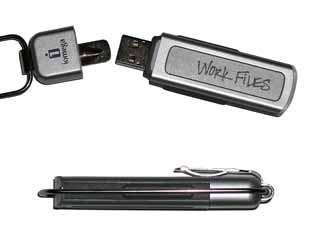
A Pen With a Memory
(October, 2004)
They’re called Pen Drives, Thumb Drives, Jump Drives, Flash Drives, DiskOnKey, and Mini-disk Drives. They’re probably called more names than someone doing 35 mph in the fast lane on Highway 70 during rush hour. Whatever you call them, they’re the new cool thing to have if you’re a computer geek. They’re even sold with lanyards to wear around your neck so you can display them for all the world to see, your tool of the trade at the ready just like a coach’s whistle. And you can buy them with replaceable caps to color coordinate your outfits.
What’s the world coming to when computer geeks start to color coordinate accessories with their clothes? For that matter, what in the world am I talking about?
Listen up, sonny, let me tell you how it was. About a dozen years ago I was given a new computer at work. It came with a 250 megabyte hard drive to store my data files . I can remember thinking what a waste of money that was, since there was no way I was ever going to fill that massive drive in my lifetime. Well here we are in 2004, and new computers are regularly sold with 80 gigabyte hard drives, about 32 times the storage space of that ‘lifetime’ drive. Heck, Microsoft’s new Service Pack 2 for Windows XP, which fixes existing software bugs by replacing them with new ones, would fill that 250MB drive all by itself. (There are 1,000 Megabytes in a Gigabyte, and there are one billion bacteria in a DogByte). Fortunately, advances in technology have allowed the cost of all that storage space to come way down. Today’s 80GB drive sells for a fraction of what that 250MB drive sold for a dozen years ago.
Back in the early 90s, you stored data on small hard drives or on floppy diskettes. Today we rely primarily on massive disk drives, writeable CD disks, and more recently DVD disks which hold the equivalent of 7 CDs, and much more with the new dual layer drives.

The latest form of data storage is the Pen Drive, also known by all the other names ascribed above. But instead of bigger being better, the new ‘in’ thing is smaller and lighter. It takes advantage of a computer’s USB port, which older machines did not have. Pen drives are also called Thumb drives, because that pretty well describes their size. They can look like a squared off BIC lighter. They are solid state flash memory devices that basically take the same memory concept used in digital cameras and apply it to computers. You can erase and rewrite the drives as needed, but if necessary the drives are expected to retain data for as long as ten years. Storage capacity usually ranges between 128MB and 1GB, pretty tiny by today’s standards.
The Pen Drive is a plug-n-play device. Plug it into a Windows machine, go to your ‘My Computer’ icon, and you will find that your machine is reporting the existence of a new hard drive. Transporting data takes on a new level of ease with a Pen Drive. Want to take some digital pictures with you to the relatives? Drag and drop some files into the Pen Drive, unplug it and stick it in your pocket, and when you get to your destination, plug it into the other PC’s USB port. With Windows 2000, ME, or XP, no driver software is required. With Windows 98, you’ll need to install a driver file. Still running Windows 95? Sorry, you’re looking in the window with your nose pressed against the glass.
Portability and durability are the selling points of Pen Drives. With solid state electronics and no moving parts, they’re made to withstand the travails of life on the road. I’ve read stories of people mistakenly leaving them in their pants pockets through a complete wash and dry laundry cycle. And the amazing thing is, they still work! Try doing that with a regular hard drive – Ha! Then again, if you can leave a regular hard drive in your pants pocket without knowing it, you’re wearing some seriously large pants.
Pen Drives will run on older USB ports, but they’re really made for the newer USB 2.0 ports. If you buy a Pen Drive, you want to make sure it is a USB 2.0 Hi-Speed drive, not just Full Speed. According to the folks at arstechica.com, from whom I have gleaned many of the technical facts in this article, USB 2.0 has three signaling rates: low speed (1.5 Mbps), full speed (12Mbps, equivalent to USB 1.1 specs), and Hi-Speed (480Mbps). Even if you don’t know what Mbps means (megabits per second), you can figure out that 480 is a lot bigger number than 12, and in this case more is better. Data will transfer to and from the drive a whole lot faster with Hi-Speed USB 2.0.
So if you want to go beyond geeky and get all the way to cool, you’ll need to hang a color-coordinated Pen Drive from a rope around your neck. But there’s a price for being cool. Consider that a Pen Drive that holds 256 MB, about the same as my former lifetime hard drive, will set you back about forty bucks as I write this. You could also burn that precious data to a rewriteable CD-ROM that can hold nearly three times as much data and would cost you, oh, about forty CENTS! Ouch! So Pen Drives clearly require owners with special needs and thick wallets. But the manufacturers are selling boat loads of these things, so clearly the little rascals are filling a niche. Besides, wearing a CD disk hanging from a rope around your neck would make you look downright silly.
If you’d like to read a more serious and in-depth review of Pen Drives, check out the website at http://arstechnica.com/reviews/004/flash/flash-1.html